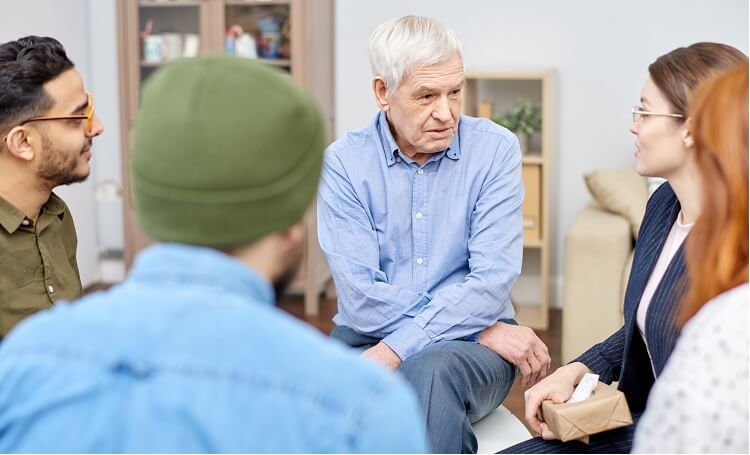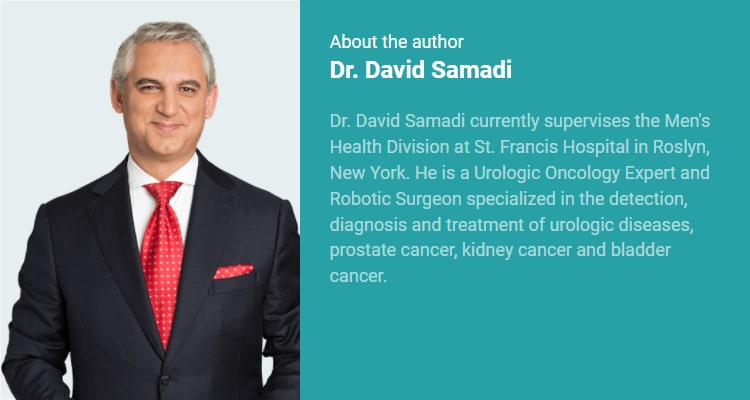- About
- Services
- Prostate Cancer
- Erectile Dysfunction
- Robotic Surgery
- Enlarged Prostate
- Urinary Issues
- Elevated PSA
- Bladder Cancer
- MRI Fusion Biopsy
- Urologic Cancer
- Prostate Biopsy
- PSA Screening and Monitoring
- Robotic Prostatectomy
- Focal Therapy for Prostate Cancer
- Second Opinions for Prostate Cancer
- Bladder Tumor Resection
- BPH Treatment Options
- Patient Info
- Patient Education
- Blog
- Contact
The journey a man diagnosed with prostate cancer has to go through is usually long and painful. Starting from the first feelings of fear and anger a man has when receiving the prostate cancer diagnosis, to the responsibility of deciding upon the best treatment to follow, the burden a prostate cancer patient has to bear may be overwhelming.
The quality of life men have after prostate cancer varies depending on the treatment they choose, their physical condition before treatment and the experience of their surgeons. Most men worry that after the cancer is gone, they will be left with urinary incontinence and/or erectile dysfunction. However, if these two side effects can be controlled with treatments and prevention methods, the fear of cancer recurrence is something you can’t control, but that you can learn to live with. It is very important to know what your particular risk of recurrence is and what are some practical ways that could lessen or influence this risk.

1. Develop a care plan
After you have completed the treatment for prostate cancer, your doctor will discuss a care plan with you.
This plan may include frequent follow-ups in the first weeks and months after treatment. The purpose of these follow-ups is to allow the doctor to closely monitor your progress and track any changes. A check-up may include a PSA test and/or a DRE exam twice a year for the first five years. After that, follow-ups may be less frequent.
Make sure to attend these appointments as they may be vital, given that cancer may reoccur. Also, they are great opportunities to talk to your doctor about any changes in your symptoms that may affect your quality of life. What is more, discuss openly with your doctor about your personal risk of having recurrent prostate cancer or another type of cancer.
2. Risk factors of prostate cancer recurrence
It is normal to think about the fact that cancer may come back. There are some factors that may determine what is the likelihood to have cancer recurrence.
- Tumor size – Usually, prostate cancer is diagnosed and treated at an early T stage, when the tumor is still organ-confined (involving one or both lobes of the prostate) and has not spread outside the prostatic capsule. However, there are rare cases when the tumor is much larger at the moment of diagnosis. The larger the tumor, the greater the likelihood to have cancer recurrence.
- Gleason Score – The Gleason Score, determined after a biopsy, is calculated based on the Gleason grade of the primary and secondary prostate cells pattern. Grade 5 prostate cells are considered already mutations and stop resembling normal cells. The higher the Gleason Score, the bigger the chance to have prostate cancer again.
- Prostate cancer stage – Usually, the prostate cancer stage is determined based on the TNM system. This system involves the analysis of the tumor, lymph nodes and whether the cancer has metastasized or not. If the cancer stage was more advanced at the moment of diagnosis, involving lymph nodes or even metastasis, the chance of cancer recurrence is higher compared to early-stage prostate cancer.
3. Common side effects of prostate cancer treatment
The side effects men usually experience depend on the type of prostate cancer treatment they have undergone. For example, the side effects of radiation can differ from those caused by surgery. Also, it is important to know that compared to open prostate surgery and laparoscopic surgery, robotic surgery is the least invasive and causes temporary side effects. But what side-effects can you expect after prostate cancer treatment?
- Urinary problems – Tissues’ irritation, caused by radiotherapy or other treatment, may trigger various urinary problems, such as frequency, urgency, painful urination or leakage. After surgery, most men regain their urinary control after a year.
- Erectile dysfunction – Erectile dysfunction is the most common side effect of prostate cancer treatment. Radiation therapy, for example, can damage the nerves and blood vessels that can result in decreased erectile function. On the other side, the goal of a prostatectomy is to spare the nerves adjacent to the prostate. If cancer has already spread past the nerves outside the prostatic capsule, then the erectile function rates can be lower.
- Rectal problems – The rectum sits close to the prostate and can be affected by prostate cancer treatment. Radiation therapy may trigger rectal problems, including diarrhea or rectal bleeding. Talk to your doctor about what form of radiation is suitable for you, as the older forms of radiation may cause more severe rectal problems. Also, if the prostate cancer has invaded the rectum, then the treatment will cause rectal damage. It is notable that in prostatectomy it is very rare (1%) to experience rectal problems in the long run. Anyway, these problems usually resolve in 6-12 months.
- Infertility – During surgery, both the prostate and the semen vesicles are removed. Orgasm will be possible to achieve, but without ejaculation. Radiation therapy affects fertilization, the sperm being damaged. This being the case, sperm banking is a solution for those who may want to have children after prostate treatment.
- Fatigue – Radiation or chemotherapy usually causes extreme tiredness or fatigue. These symptoms may even continue after a man has entered remission. Reactions to drugs may differ from patient to patient, but it is important to be aware of the symptoms that can affect your daily activities.

Lifestyle changes that can help you manage your side-effects or lessen your risk of cancer recurrence
There are a few manageable factors that can influence the way our bodies fight against the disease and contribute to the success of the treatment. Also, if you are at risk of developing recurrent prostate cancer, here is a list of things you CAN do to reduce the likelihood of your cancer returning.
Treatment options for locally advanced prostate cancer
- Exercise regularly – There are many studies that have suggested that men who exercise regularly are less likely to die from prostate cancer. A good routine of physical exercise is linked to a balanced bodyweight, which is an important factor in recovery after treatment. Men who are obese have a poorer outcome, compared to those who are well fit.
- Quit smoking – An important study made it clear that smoking affects a man’s survival rate when diagnosed with prostate cancer. It is well known that smoking contributes to the development and progress of many types of cancer, including prostate cancer.
- Diet and nutritional supplements – A healthy diet, rich in vegetables and omega 3 and 6, can have many benefits on your overall health. Avoid animal fats and sweets. Why? At high temperatures, meat may form chemicals that produce changes in the DNA and, thus, increase the risk of prostate cancer recurrence. In terms of vitamins and supplements, consider avoiding the intake of selenium and vitamin E, which were considered for a long time beneficial for prostate health. Instead, Boron supplements or vitamin D can positively impact the prostate. It is very important not to take any supplement without having a prior discussion with your doctor.

Emotional support for prostate cancer patients
Feelings of anger, depression, sadness or grief are normal when dealing with cancer. If you have already finished your treatment and have entered remission, you would probably want to share your experience and benefit from others’ stories. The help provided by family and friends is very valuable, but you would probably need emotional support and advice from those who are or were in your shoes, struggling with the same feelings. Until now, you have benefited from the support offered by your cancer care team, but now your appointments become rarer and you probably feel anxious.
It is important to face these feelings and learn to deal with them. Just give yourself enough time to get accustomed to your life after treatment and do not expect your life to suddenly come back to normal.
Of course, it is not always possible to have a positive attitude, but it is worth the effort. Anyway, note that there are numerous myths regarding a positive attitude that can even fight and defeat cancer, which was never proved to be real. Don’t let anyone make you feel guilty for your negative feelings, it is normal to feel sad sometimes.
Many cancer support groups were formed with the purpose of encouraging and providing comfort to those affected by cancer. Researchers found out that people who take part in support groups and attend the meetings, have an improved quality of life and can sleep and eat better. There are online communities and support services and programs. Find out here what support service is available in your area.
